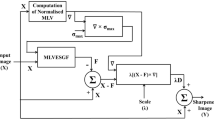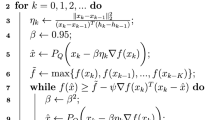Abstract
Acutance is a subjective parameter which indicates the quality of edges in an image. Objective metrics for measuring image acutance are helpful for designing new imaging protocols and sequences in magnetic resonance imaging (MRI) studies. In addition to this, image acutance metrics have a significant role in the design and optimisation of post-processing algorithms used for restoration and sharpening of MR imagery. Most of the existing blur/sharpness metrics are specifically designed for natural-scene (panoramic) images. A blur/sharpness metric suitable for MR imaging applications is absent in the literature. To fill this gap, a computationally fast metric, ‘largest local gradient-based sharpness metric (LLGSM)’, for measuring sharpness and blur in MR imagery, is proposed in this paper. The LLGSM is the root mean square (RMS) of exponentially weighted elements in an array of lexicographically ordered largest local gradient (LLG) values in the image, sorted in descending order. In terms of overall agreement with subjective scores, and computational speed, the LLGSM is observed to be more efficient than its alternatives available in the literature.
Graphical abstract













Similar content being viewed by others
Explore related subjects
Discover the latest articles, news and stories from top researchers in related subjects.Availability of data and material
Data may be provided on request.
Code availability
Code can be made available on request.
References
Osadebey M, Pedersen M, Arnold D, Wendel-Mitoraj K (2018) Image quality evaluation in clinical research: a case study on brain and cardiac MRI images in multi-center clinical trials. IEEE Journal of Translational Engineering in Health and Medicine 6:1–15
Esslinger D, Rapp P, Knödler L et al (2019) A novel finite element model–based navigation system–supported workflow for breast tumor excision. Med Biol Eng Compu 57:1537–1552. https://doi.org/10.1007/s11517-019-01977-0
Zhao L et al (2017) Using anatomic magnetic resonance image information to enhance visualization and interpretation of functional images: a comparison of methods applied to clinical arterial spin labeling images. IEEE Trans Med Imaging 36(2):487–496
Singh M, Verma A, Sharma N (2018) Optimized multistable stochastic resonance for the enhancement of pituitary microadenoma in MRI. IEEE J Biomed Health Inform 22(3):862–873
Vivek U, Salim M (2021) Comparative study of compressive sensing approach in T1, T2, and proton density-based MRI images. IEIE Transact Smart Process Comput (3):219–226
Vivek U, Salim M (2021) To analyse the effect of relaxation type on magnetic resonance image compression using compressive sensing. Int J Online Biomed Eng 17(4)
Chen Z, Zhou Z, Adnan S (2021) Joint low-rank prior and difference of Gaussian filter for magnetic resonance image denoising. Med Biol Eng Compu 59:607–620. https://doi.org/10.1007/s11517-020-02312-8
Chen L, Tang C, Xu M et al (2021) Enhancement and denoising method for low-quality MRI, CT images via the sequence decomposition Retinex model, and haze removal algorithm. Med Biol Eng Compu 59:2433–2448. https://doi.org/10.1007/s11517-021-02451-6
Ferrari RJ (2013) Off-line determination of the optimal number of iterations of the robust anisotropic diffusion filter applied to denoising of brain MR images. Med Biol Eng Compu 51:71–88. https://doi.org/10.1007/s11517-012-0971-z
Subudhi A, Jena S, Sabut S (2018) Delineation of the ischemic stroke lesion based on watershed and relative fuzzy connectedness in brain MRI. Med Biol Eng Compu 56:795–807. https://doi.org/10.1007/s11517-017-1726-7
Simi VR, Edla DR, Joseph J (2021) A no-reference metric to assess quality of denoising for magnetic resonance images. Biomed Signal Process Control 70:102962. https://doi.org/10.1016/j.bspc.2021.102962
Feichtenhofer C, Fassold H, Schallauer P (2013) A perceptual image sharpness metric based on local edge gradient analysis. IEEE Signal Process Lett 20(4):379–382
Panetta K, Zhou Y, Agaian S, Jia H (2011) Nonlinear unsharp masking for mammogram enhancement. IEEE Trans Inf Technol Biomed 15(6):918–928
Li L, Wu D, Wu J, Li H, Lin W, Kot AC (2016) Image sharpness assessment by sparse representation. IEEE Trans Multimedia 18(6):1085–1097
Hassen R, Wang Z, Salama MMA (2013) Image sharpness assessment based on local phase coherence. IEEE Trans Image Process 22(7):2798–2810
Ferzli R, Karam LJ (2009) A no-reference objective image sharpness metric based on the notion of just noticeable blur (JNB). IEEE Trans Image Process 18(4):717–728
Narvekar ND, Karam LJ (2011) A No-reference image blur metric based on the cumulative probability of blur detection (CPBD). IEEE Trans Image Process 20(9):2678–2683
Vu CT, Phan TD, Chandler DM (2012) S3: a spectral and spatial measure of local perceived sharpness in natural images. IEEE Trans Image Process 21(3):934–945
Simi VR, Edla DR, Joseph J (2021) An inverse mathematical technique for improving the sharpness of magnetic resonance images. J Ambient Intell Humaniz Comput. https://doi.org/10.1007/s12652-021-03416-1
Joseph J, Periyasamy R (2019) Nonlinear sharpening of MR images using a locally adaptive sharpness gain and a noise reduction parameter. Pattern Anal Appl 22:273–283. https://doi.org/10.1007/s10044-018-0763-7
Anoop BN, Joseph J, Williams J et al (2018) A prospective case study of high boost, high frequency emphasis and two-way diffusion filters on MR images of glioblastoma multiforme. Australas Phys Eng Sci Med 41:415–427. https://doi.org/10.1007/s13246-018-0638-7
Renuka SV, Edla DR, Joseph J (2021) An objective measure for assessing the quality of contrast enhancement on magnetic resonance images. Journal of King Saud University - Computer and Information Sciences. https://doi.org/10.1016/j.jksuci.2021.12.005
Joseph J, Anoop BN, Williams J (2019) A modified unsharp masking with adaptive threshold and objectively defined amount based on saturation constraints. Multimedia Tools and Applications 78:11073–11089. https://doi.org/10.1007/s11042-018-6682-1
Seshadrinathan K, Soundararajan R, Bovik AC, Cormack LK (2010) Study of Subjective and Objective Quality Assessment of Video. IEEE Trans Image Process 19(6):1427–1441
Author information
Authors and Affiliations
Corresponding author
Ethics declarations
Compliance with Ethical Standards
This article does not contain any studies with human participants or animals performed by any of the authors.
Conflict of Interest
The authors declare no competing interests.
Additional information
Publisher's Note
Springer Nature remains neutral with regard to jurisdictional claims in published maps and institutional affiliations.
Rights and permissions
About this article
Cite this article
Venuji Renuka, S., Edla, D.R. & Joseph, J. A customized acutance metric for quality control applications in MRI. Med Biol Eng Comput 60, 1511–1525 (2022). https://doi.org/10.1007/s11517-022-02547-7
Received:
Accepted:
Published:
Issue Date:
DOI: https://doi.org/10.1007/s11517-022-02547-7




